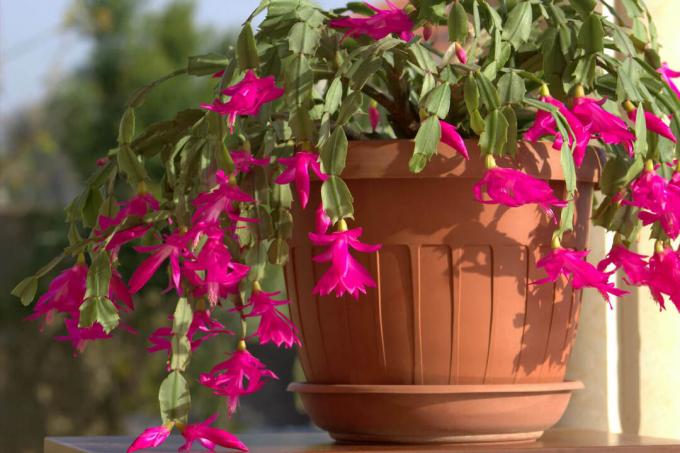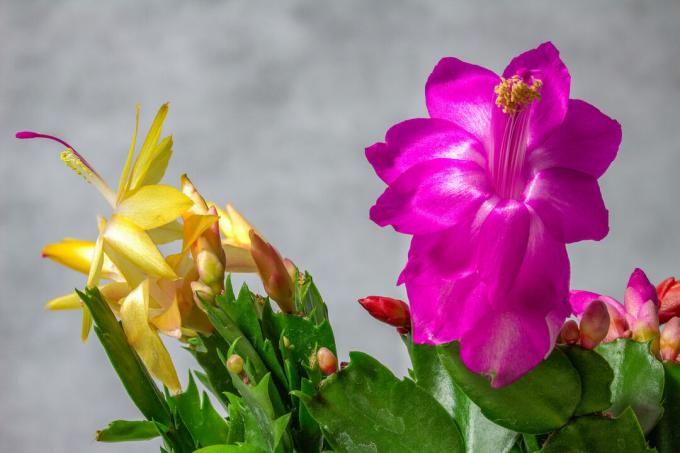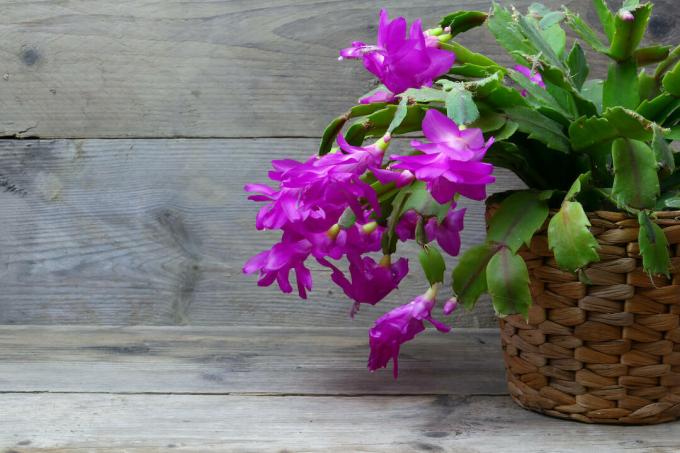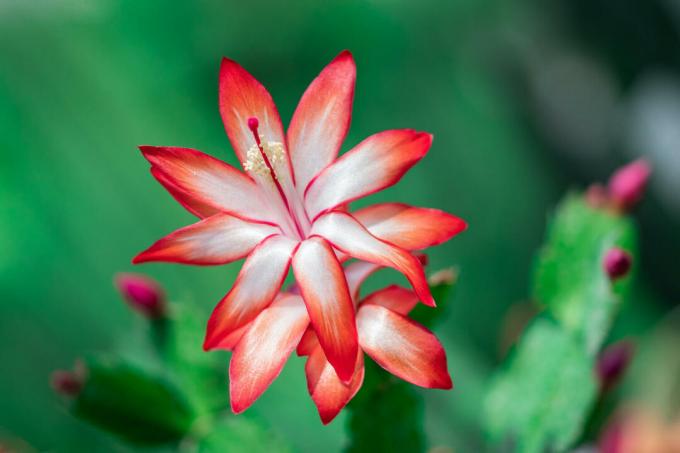If the location and care are right, the Christmas cactus will delight with a large number of flowers. But at which location does it feel comfortable and how is it properly watered and fertilized?

The varieties of the Christmas cactus (Schlumbergera x buckleyi), which can be bought in this country in winter, are hybrids. They are obtained by crossing different wild species from the genus Schlumbergera developed. These wild species are native to tropical and subtropical areas of Brazil. Due to its tropical origin, the Christmas cactus has special requirements that should be considered when it comes to location and care.
Tip: Depending on the temperature and lighting, the Christmas cactus can even bloom several times a year.
contents
- Christmas cactus: origin and properties
- The most beautiful Schlumbergera species and varieties
- The right location for the Christmas cactus
-
Cultivate Christmas cactus
- Water the Christmas cactus properly
- Fertilize Christmas cactus properly
- Christmas cactus has yellow or limp leaves: what to do?
- wintering
Christmas cactus: origin and properties
The Brazilian wild species of the genus Schlumbergera grow terrestrial or epiphytic. Epiphytes are also referred to as "mountain plants" because they do not come into direct contact with the soil contact, but sit on trees or larger plants - albeit without parasitically attacking their carrier serve. The terrestrially growing Schlumbergera root with their fine roots in the soil of the tropical rain forest. The leaves are absent or are severely reduced. The shoot axis consists of the so-called platyclades, which botanically represent a shoot metamorphosis. They take over the photosynthesis instead of the leaves. The edges of the individual links are usually more or less indented and covered with bristles, so-called trichomes.
Due to the long shoots, the Christmas cactus looks very decorative in a traffic light pot. It reaches sizes of about 40 cm. The colorful flowers are at the end of the shoots. Depending on the variety, they can have a wide range of colors, from white to yellow to red and pink. The special thing about the Christmas cactus is its flowering time. She also gave the Christmas cactus its German name because it blooms as a houseplant between December and February.

What is the difference between Christmas cactus and Easter cactus? The biggest difference between Christmas cactus and Easter cactus (Hatiora x grasseri) is the heyday. As the name suggests, the Easter cactus flowers in the spring and not in the winter like the Christmas cactus. The Easter cactus also belongs to a completely different plant genus, namely the genus Hatiora. The flower shapes of the two genera also differ.
The most beautiful Schlumbergera species and varieties
As already mentioned, the Christmas cacti that we use as indoor plants are hybrids of the wild species. The about six different ones Schlumbergera-Types, to which for example the articulated cactus Schlumbergera trucata belongs, not all are suitable for indoor culture. Known Schlumbergera- Varieties are:

- ‘Victoria’: With this variety you get a Christmas cactus in white
- ‘Thor Sophia’: A Christmas cactus with yellow-orange flowers
- 'Thor Olivia': With orange-red flowers

- ‘Esperito Brasil’: Blooms in pink
- ‘Christmas Flame’: With salmon-colored flowers
- ‘Samba Brazil’: Multicolored flowers that are white on the inside and turn yellow and orange to red on the outside

The right location for the Christmas cactus
The Christmas cactus doesn't particularly like temperatures below 10 °C, after all it comes from the warm rain forest. It should therefore find its place as a houseplant in the house. In summer you can also put it outside. In any case, a semi-shady location for the Christmas cactus should be chosen both indoors and outdoors, because full sun does not appeal to it. However, if the temperatures drop below 10 °C in autumn, you should bring it back indoors immediately to avoid damage from the cold.
The optimal location for the Christmas cactus:
- Room temperatures of 19 - 23 °C are suitable for the Christmas cactus, temperatures below 10 °C should be avoided
- Mainly kept as a houseplant
- If the temperatures allow it, he can spend the summer outside
- Choose a semi-shady location - the Christmas cactus does not tolerate full sun

To the to make the Christmas cactus bloom, it is time for the formation of buds in autumn. For this you should keep the Christmas cactus a little cooler at around 15 °C from September. In addition, it should be exposed to light for a maximum of nine hours. Flower formation requires a room in which no lamp is switched on in the evening. Alternatively, a cardboard box can be placed over the plant. As soon as the flower buds form, it is beneficial for the development of the buds to increase the light supply and the temperature, to around 20 °C. These conditions can be maintained until summer when the Christmas cactus is allowed to move outside again.
- Reduce the temperature to about 15 °C for flowering
- Reduce the amount of light available to a maximum of 9 hours per day, avoid stray light at all costs
- As soon as flower buds form, choose a bright location and increase the temperature to 20 °C
- Provide a light and warm location outdoors during the winter until oversummer

Even if the Christmas cactus is not planted in the bed: the substrate naturally plays a decisive role in root formation in pot culture. Commercial potting soil with a pH of 5.5 to 6.0 is suitable. In addition, the substrate should be as permeable as possible, since the Christmas cactus is very sensitive to waterlogging. You can easily achieve permeability by adding sand to the substrate: one part sand to three parts soil. A drainage layer at the bottom of the pot protects the Christmas cactus from waterlogging. This should consist of coarse material such as potsherds, expanded clay or pebbles.
Which substrate is suitable for the Christmas cactus?
- drainage layer applied
- Substrate: Commercial potting soil
- A pH of 5.5 to 6.0 is optimal
- Choose soil with a loose, water-permeable structure
- Mix sand into the substrate to promote permeability and counteract waterlogging (1 part sand to 3 parts substrate)
Cultivate Christmas cactus
The care of the Christmas cactus is highly dependent on the seasons. In autumn and spring, i.e. from September to December and from February to March, the Christmas cactus is in the dormant phase. The growth phase takes place in summer, from April to August. The flowering period for the Christmas cactus is from December to February. The dormant phases in particular differ greatly in terms of care from the growth and flowering periods. Since particularly strong platyclades also produce more flowers, this phase is extremely important if you want a rich bloom.
Water the Christmas cactus properly
How often you have to water the Christmas cactus depends not only on the season, but also on the temperature of the location. During flowering, the substrate should always be kept slightly moist. In the dormant phase, which follows flowering, watering can be reduced. However, it is important to ensure that the Christmas cactus does not dry out completely. The beginning of the growth phase can be recognized by the new shoots. The water requirement increases, which is why you should water more often again. In autumn, when the second period of dormancy before flowering begins, watering is again greatly reduced.

Especially if the Christmas cactus spends the summer outdoors, you have to water it every two to three days. A sheltered spot should also be chosen to protect it from waterlogging on rainy summer days. The substrate should be kept moderately but evenly moist. Neither too much moisture nor complete dryness have a positive effect on the development of the Christmas cactus. During the dormant phase before flowering, watering can be largely stopped. Always use lime-free water to water the Christmas cactus. Because in its homeland, the tropical rainforest, it also lives with slightly acidic rainwater.
At a glance: watering the Christmas cactus
- In winter, when flowering, keep the soil slightly moist
- In the spring, during the dormant phase, reduce the amount of water, but do not let the soil dry out
- In the summer, during the growing season, water regularly and keep the soil slightly moist
- In autumn, with the resting phase before flowering, reduce watering significantly, almost stop it altogether

Tip: The Christmas cactus also appreciates high humidity. Therefore, spray it occasionally with lime-free water.
Fertilize Christmas cactus properly
Especially during the growth phase, the Christmas cactus is dependent on fertilizer, even if its nutrient requirements are low. There is no need to fertilize during flowering, in the dormant phase before it and in the time between flowering and new growth in spring. A liquid fertilizer like ours is quick and easy to use Plantura organic indoor and green plant fertilizer. This is simply administered via the irrigation water and is therefore a good choice for potted plants such as the Christmas cactus. The nutrients are also available to the plant more quickly than, for example, horn shavings or compost. Our organic fertilizer is applied to the Christmas cactus about every four weeks during the growth phase from April to September.

Fertilize Christmas cactus at a glance:
- No fertilization required during flowering and dormant periods before and after flowering
- You should fertilize between April and August
- Consider information on the correct application of the respective fertilizer
- Fertilize about every four weeks during the growth phase
Christmas cactus has yellow or limp leaves: what to do?
Yellow leaves on the Christmas cactus mostly appear due to care mistakes. These are the most common causes:
- waterlogging: Like most indoor plants, the Christmas cactus does not tolerate waterlogging. It can even happen that the Christmas cactus sheds shoots. If the substrate is wet and smells putrid, the Christmas cactus should be quickly repotted in fresh soil. A drainage layer at the bottom of the pot ensures that the water can always drain away easily. Excess irrigation water must be removed 15 minutes after watering.
- Dryness: Much less often, drought is the cause of limp leaves in the Christmas cactus. However, if the soil also feels dry in the root area, it must be watered more regularly. Be sure to use lime-free water.
- Nutrient: Regular fertilizing is important for the Christmas cactus during the growing season to keep it healthy. Too few nutrients can be responsible for yellow and limp leaves. But you shouldn't overdo it either, because its requirement is rather low - too many nutrients endanger the rich blossoms.

Christmas cactus gets red leaves: As with most cacti, if the Christmas cactus develops red leaves, this is usually a sign of too much direct sunlight. In this case, you should place the Christmas cactus in a less sunny, partially shaded location.
wintering
The Christmas cactus is not hardy. The tropical plant requires temperatures of over 10 °C all year round. Especially in winter, during the flowering period, it should be placed bright and warm.
If the Christmas cactus is well cared for and develops splendidly, it can easily be propagated. How to Propagate, cut and repot the Christmas cactus should, you will find out in our article.
